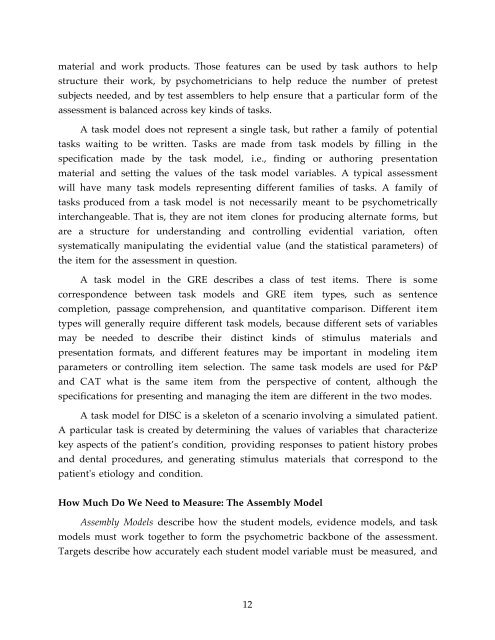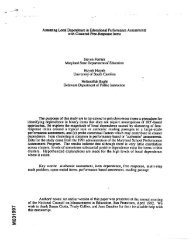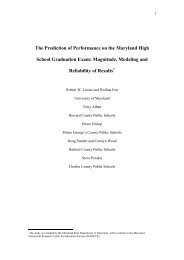A Brief Introduction to Evidence-Centered Design CSE Report 632 ...
A Brief Introduction to Evidence-Centered Design CSE Report 632 ...
A Brief Introduction to Evidence-Centered Design CSE Report 632 ...
Create successful ePaper yourself
Turn your PDF publications into a flip-book with our unique Google optimized e-Paper software.
material and work products. Those features can be used by task authors <strong>to</strong> helpstructure their work, by psychometricians <strong>to</strong> help reduce the number of pretestsubjects needed, and by test assemblers <strong>to</strong> help ensure that a particular form of theassessment is balanced across key kinds of tasks.A task model does not represent a single task, but rather a family of potentialtasks waiting <strong>to</strong> be written. Tasks are made from task models by filling in thespecification made by the task model, i.e., finding or authoring presentationmaterial and setting the values of the task model variables. A typical assessmentwill have many task models representing different families of tasks. A family oftasks produced from a task model is not necessarily meant <strong>to</strong> be psychometricallyinterchangeable. That is, they are not item clones for producing alternate forms, butare a structure for understanding and controlling evidential variation, oftensystematically manipulating the evidential value (and the statistical parameters) ofthe item for the assessment in question.A task model in the GRE describes a class of test items. There is somecorrespondence between task models and GRE item types, such as sentencecompletion, passage comprehension, and quantitative comparison. Different itemtypes will generally require different task models, because different sets of variablesmay be needed <strong>to</strong> describe their distinct kinds of stimulus materials andpresentation formats, and different features may be important in modeling itemparameters or controlling item selection. The same task models are used for P&Pand CAT what is the same item from the perspective of content, although thespecifications for presenting and managing the item are different in the two modes.A task model for DISC is a skele<strong>to</strong>n of a scenario involving a simulated patient.A particular task is created by determining the values of variables that characterizekey aspects of the patient’s condition, providing responses <strong>to</strong> patient his<strong>to</strong>ry probesand dental procedures, and generating stimulus materials that correspond <strong>to</strong> thepatient's etiology and condition.How Much Do We Need <strong>to</strong> Measure: The Assembly ModelAssembly Models describe how the student models, evidence models, and taskmodels must work <strong>to</strong>gether <strong>to</strong> form the psychometric backbone of the assessment.Targets describe how accurately each student model variable must be measured, and12






